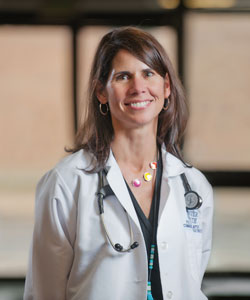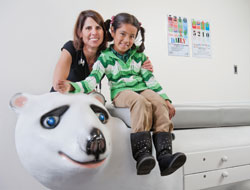
Dr. Patty Braun
Photo: Dr. Patty Braun
by Christopher Close
"Healthy smiles are the door to opportunity," says Denver, Colorado pediatrician Dr. Patty Braun. "Brown or missing teeth don't help kids—or adults—one bit."
Braun is an associate professor of Pediatrics and Family Medicine at the University of Colorado Denver School of Medicine with a master's degree in public health. She is passionate about improving children's oral health. "Tooth decay is the number one chronic infectious disease in children," she said. It disproportionately affects disadvantaged and underserved communities and it's especially common in the Native American population, which has some of the country's greatest medical and dental health disparities.

Dr. Patty Braun, a pediatrician and associate
professor at the Colorado Denver School of
Medicine,is also a co-investigator with the
NIDCR-funded Center for Native Oral
Health Research.
Photo: Dr. Patty Braun
Since 2008, Braun has played a key role in the Cavity Free at Three Oral Health Initiative, a statewide Colorado program to prevent oral disease in young children. The goal is to build partnerships among dentists, physicians, nurses, dental hygienists, public health practitioners, and early childhood educators in the prevention and early detection of oral disease in pregnant women, infants, and toddlers.
"Tooth decay is preventable but it can progress rapidly when it starts," says Braun. "That can lead to severe medical consequences, such as progressive, invasive infection and pain, difficulty eating, and visits to the emergency room. It can also cause lowered self-esteem."
As leader of the Dental Hygienist Co-location project, Braun also has placed dental hygienists into general medical and pediatric practices. "The child can be seen in one place and the healthcare providers can work together. That means less stress for the child."
In a project funded by the National Institute of Dental and Craniofacial Research, she is working to reduce tooth decay among Native Americans by training community oral health specialists. These community members teach the benefits of good oral health practices to children in Head Start classrooms—and through them, their parents. "Parents can help with tooth brushing and seeing that their children get regular dental care," says Braun. "Tooth decay is a family illness. Giving parents the knowledge of how to prevent empowers them to act. "My dream is that someday all kids will come to expect good teeth—regardless of their social or economic status."
Children's Dental Health / What Parents Can Do: Babies & Toddlers / What Parents Can Do: School Age Children / Improving Dental Health in Underserved Communities / Latest Research from NIH's National Institute of Dental and Craniofacial Research
Summer 2012 Issue: Volume 7 Number 2 Page 25-26
